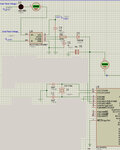noel_t
Junior Member level 3

Dear Friends,
Project Description: Data Acquisition System for Solar Panel
In fact, i need to measure the current from solar panel and display it on the LCD.
I am using PIC16F877A with C language to do so. For the Temperature, Light, and Voltage, there is no issue of reading the sensors and it is working perfectly. However, ACS712 hall effect sensor is mentioned to be a good solution for DC current measurement in the datasheet as well as having a linearity characteristic, but the time i am using it with PIC, it does not give me a true value within at least 0-50 A input ranges.
This is the Proteus + ADC codes, Please help me to accomplish this task as well.
ADCON0=CHANNEL3;
lcd_goto(44);
read_adc();
current=read_temp();
current=0.074*current;
current=(current-37.888);
current=current/2;
dis_num(current);
send_char('.');
dis_num(current%10);
send_char(' ');
send_char('A');
send_char(' ');


Project Description: Data Acquisition System for Solar Panel
In fact, i need to measure the current from solar panel and display it on the LCD.
I am using PIC16F877A with C language to do so. For the Temperature, Light, and Voltage, there is no issue of reading the sensors and it is working perfectly. However, ACS712 hall effect sensor is mentioned to be a good solution for DC current measurement in the datasheet as well as having a linearity characteristic, but the time i am using it with PIC, it does not give me a true value within at least 0-50 A input ranges.
This is the Proteus + ADC codes, Please help me to accomplish this task as well.
ADCON0=CHANNEL3;
lcd_goto(44);
read_adc();
current=read_temp();
current=0.074*current;
current=(current-37.888);
current=current/2;
dis_num(current);
send_char('.');
dis_num(current%10);
send_char(' ');
send_char('A');
send_char(' ');



